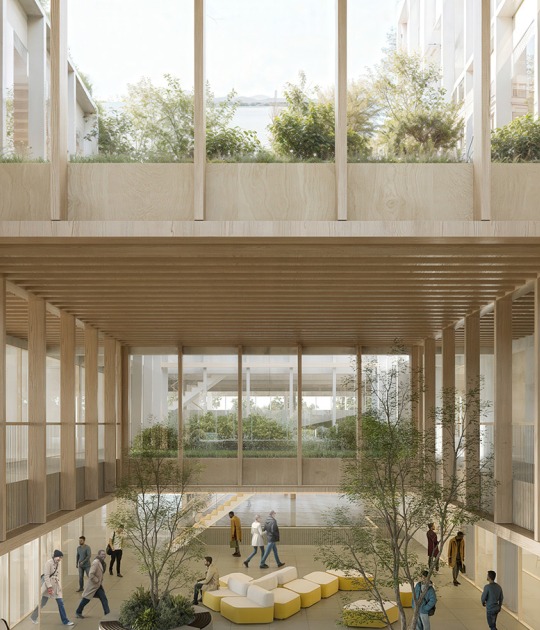
The innovative idea of the opening mechanism was central to the approach of the project team formed by Moxon Architects and COWI, as it defined its materiality. Pedestrian and cyclist circulations will be separated from vehicle circulations by vertical structural beams, which form part of the main load-bearing structure of the bridge. This contributes to shaping a slender side profile for the bridge, while at the same time improving pedestrian and cyclist safety.
The main active traffic flow will be located on the eastern side of the crossing, providing an unobstructed view of the sea, while the opposite side could transform its use in the future and be exploited by Dublin’s Luas tram system. The new crossing will be the easternmost road bridge over the River Liffey and will allow for rapid road transport of containers from the port to a separate rail facility in the vicinity of the North Harbour.

Supported by two reclining steel arms, we find a reconstituted granite counterweight located on a pair of pivots separate from the opening platform. The counterweight arms engage the girders in the open and closed position, generating a choreographed opening sequence as the two elements pass each other. The counterweight comes into play earlier in the opening sequence than is the case with a typical bascule bridge, due to the spacing of the pivots, thereby reducing energy use and carbon.
Together, they form a symbolic gateway to Dublin Port over the causeway and will form a sleek, contemporary addition to Dublin’s riverside cityscape. The main leaf of the SPAR Bridge is aligned with the existing 30.5m wide navigation channel, allowing unhindered stops for ships. An additional 20.5m wide navigation channel, used by the local community, has also been retained, aligning the position of the piers with those of the nearby Tom Clarke Bridge. The V-shaped piers help to visually break up the mass of the bridge thanks to their oblique shape, giving it a singular identity. At night, the bridge's walkway effect will be enhanced by lighting along its arms.

“We are pleased to be working with our long-time collaborators COWI on our first project in Dublin - the centre of which has seen significant development in recent years and has expanded to meet the edge of the Port. The SPAR Bridge sits on this boundary and plays a key role in the development of this area, providing improved active travel connections across the River Liffey and opening up new views of the Port. Our design solution for the opening mechanism provides a dramatic opening sequence which both helps to reduce carbon and create a new landmark for the area, transforming the seaport to provide essential links between the north and south.”
Richard Thebridge, Associate at Moxon.
“COWI is delighted to be involved with the Third and Final Masterplan (3FM) project, which will unlock significant additional capacity within Dublin Port. The SPAR bridge forms a vital component within the scheme, enabling better usage of the Port’s existing land on the Poolbeg Peninsula. By removing heavy goods vehicles from the Tom Clarke Bridge, the bridge will also bring significant benefits to the wider Dublin transport network. We used an innovative opening mechanism, which allowed the counterweight to be more effective and its size was chosen to minimise the lifetime carbon emissions for both construction and operation.”
Oliver Stross, Project Director, COWI in the UK.

“For business, the 3FM project means essential port infrastructure that supports Ireland’s export ambitions into the future. For the local community and future residents, it creates new and enhanced public amenities, including a world class Maritime Village, 7km of pedestrian and cycle routes, a new public park and wildflower meadow as well as a floodlit playing pitch. We are very grateful to the many contributors for their input into this plan, which will transform our lands on the Poolbeg Peninsula for the port, the city and its residents.”
Barry O’Connell, Chief Executive at Dublin Port Company.
Formal consultation is expected to conclude in September 2024, with construction of the 3FM project expected to begin in the late 2020s and the SPAR Bridge completed in the late 2030s.
This development is one of several infrastructure projects Moxon Architects has collaborated with COWI on, including Dukes Meadow in West London, Hampton Bridge in Worcestershire, as well as ongoing work for HS2.











































